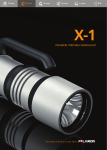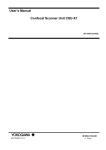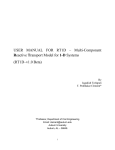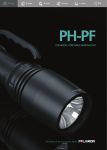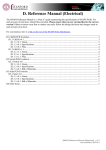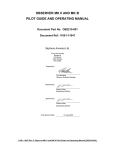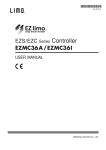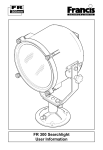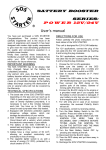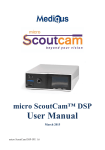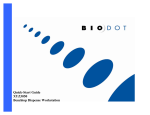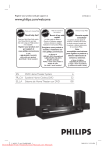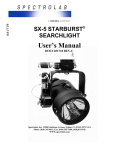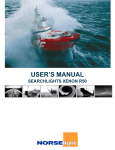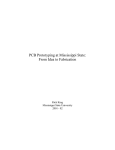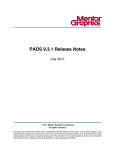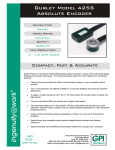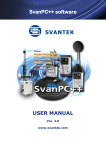Download SpectroLink Setup and Operation Manual
Transcript
SpectroLink Setup and Operations Manual 033600 Revision. G SpectroLink Setup and Operation Manual Spectrolab, Inc. Illumination Products www.Spectrolab.com SEE DOCUMENT ECR FOR APPROVAL SIGNATURES Source: Spectrolab, Inc. Page 1 of 68 SpectroLink Setup and Operations Manual 033600 Revision. G © 2011 Spectrolab, Inc. All rights reserved. This document contains material (including proprietary information) protected by copyright. No part of this document may be reproduced or transmitted in any form, by any means, or for any purpose without the express written consent of Spectrolab. Users of this document agree not to manufacture, produce, sell, or lease any product copied from or based on the information contained in this document without prior written consent from Spectrolab. Unauthorized reproduction or distribution of copyrighted material in the United States is subject to civil and criminal remedies pursuant to Title 17 of the United States Code. Spectrolab,Inc. 12500 Gladstone Avenue Sylmar, CA 91342 USA 818-365-4611 www.Spectrolab.com Document #033600. Printed in the United States of America Source: Spectrolab, Inc. Page 2 of 68 SpectroLink Setup and Operations Manual 033600 Revision. G CHANGE RECORD REV NC A B C D E F G AUTHORIZATION G.P. Estrada G.P. Estrada E. Quezada E. Quezada E. Quezada R. Moss G.P. Estrada G.P. Estrada CHANGE DESCRIPTION Per ECO Per ECO Per ECO Per ECO Per ECO Per ECO Per ECO Source: Spectrolab, Inc. Page 3 of 68 APPROVAL F. Sanchez 9/18/06 F. Sanchez 12/04/06 F. Sanchez 2/13/07 F. Sanchez 7/24/07 F. Sanchez 11/6/07 F. Sanchez 1/29/09 F. Sanchez 5/7/11 F. Sanchez 12/5/12 SpectroLink Setup and Operations Manual 033600 Revision. G Table of Contents 1. 1.1 1.1.1 1.2 1.3 1.4 1.5 1.6 1.7 1.8 2. 3. 3.1 3.2 3.2.1 3.2.2 3.2.3 4. 4.1 4.1.1 4.1.2 4.1.3 4.1.3.1 4.1.3.2 4.1.3.3 4.1.3.4 4.1.3.5 4.1.3.6 4.1.3.7 4.1.3.8 4.1.3.9 4.1.4 4.1.4.1 4.1.4.2 4.1.4.3 4.2 4.2.1 4.2.2 4.2.3 4.2.3.1 4.2.3.2 4.2.3.3 4.2.3.4 4.2.3.5 4.2.4 4.2.5 4.3 4.3.1 4.3.2 INTRODUCTION ............................................................................................................ 6 Description ...................................................................................................................... 6 Features and Capabilities for Standard and Enhanced Units ........................................ 6 Spectrolink connectors/ports .......................................................................................... 7 About This Manual.......................................................................................................... 7 Read, Obey, and Keep Instructions ............................................................................... 7 Installer Responsibility .................................................................................................... 8 Quick Start Guide ........................................................................................................... 8 Definitions ....................................................................................................................... 9 Applicable Documents .................................................................................................... 9 SYSTEM COMPONENTS ............................................................................................ 10 MOUNTING THE SPECTROLINK COMPONENTS .................................................... 11 Mounting the SpectroLink Integration Box (All Users) ................................................. 11 Mounting the Dual-Motor/Encoder Harness Assembly (Upgrade Users Only) ............ 11 Description of the Dual-Motor/Encoder Harness Assembly ......................................... 11 Mounting Procedure for the SX-16 Nightsun® ............................................................. 12 Mounting Procedure for the SX-5 Starburst ................................................................. 14 COMPONENT CONNECTIONS................................................................................... 17 SX-16 Nightsun® .......................................................................................................... 17 Overview ....................................................................................................................... 17 Cabling.......................................................................................................................... 17 Connections to the SpectroLink Integration Box .......................................................... 19 SpectroLink Integration Box to Control Box or Optional IFCO Control Box ................. 19 SpectroLink Integration Box to Linked System............................................................. 19 SpectroLink Integration Box to Gimbal Motor Encoders .............................................. 19 SpectroLink Integration Box to Junction Box................................................................ 19 SpectroLink Integration Box to Program Update Port .................................................. 19 SpectroLink Integration Box to Programmable Setup Port .......................................... 19 SpectroLink Integration Box to Maintenance Port ........................................................ 19 SpectroLink Integration Box to Digital Hand Controller (option)................................... 20 SpectroLink Integration Box to I/O Connector (option) ................................................ 20 Connections to the Junction Box .................................................................................. 20 Junction Box to Internal and External Bulkhead........................................................... 20 Junction Box to Internal and External Searchlight Gimbal Bulkhead ........................... 20 Junction Box to System Power Input ............................................................................ 20 SX-5 Starburst .............................................................................................................. 21 Overview ....................................................................................................................... 21 Cabling.......................................................................................................................... 22 Connections to the SpectroLink Integration Box .......................................................... 23 SpectroLink Integration Box to Control Box ................................................................. 23 SpectroLink Integration Box to Linked System............................................................. 23 SpectroLink Integration Box to Gimbal Motor Encoders .............................................. 23 SpectroLink Integration Box to Junction Box................................................................ 23 SpectroLink Integration Box to Program Update Port .................................................. 23 SpectroLink Integration Box to Programmable Setup Port .......................................... 23 SpectroLink Integration Box to Maintenance Port ........................................................ 23 Connections to the Junction Box .................................................................................. 24 Junction Box (Power) to Searchlight and Gimbal ......................................................... 24 Junction Box to System Power Input ............................................................................ 24 4 SpectroLink Setup and Operations Manual 033600 Revision. G 5. 5.1 5.1.1 5.1.2 5.2 5.2.1 5.2.2 5.2.2.1 5.2.2.2 5.2.2.3 5.2.3 6. 6.1 6.2 6.3 6.4 6.5 6.5.1 6.5.2 6.6 6.7 6.8 6.8.1 6.9 6.10 6.11 7. 8. 9. 10. 11. 12. 13. 14. 14.1 14.2 15. 15.1 15.2 15.3 15.4 SETUP .......................................................................................................................... 25 Linking .......................................................................................................................... 25 Link Serial Interface ...................................................................................................... 25 Compatibility ................................................................................................................. 25 Setup Menu .................................................................................................................. 26 Mechanical Gimbal Stop Adjustment Procedure .......................................................... 26 Using the Setup Menu .................................................................................................. 26 Computer Connection for Setup Menu ......................................................................... 26 HyperTerminal Setup.................................................................................................... 27 Setup Menu Display during the Power-Up Calibration Sequence................................ 30 Programmable Settings and Functionality.................................................................... 31 OPERATION ................................................................................................................ 34 Safety Guidelines ......................................................................................................... 34 SpectroLink Operations ................................................................................................ 35 Control Box Operation .................................................................................................. 35 Control Box Functions .................................................................................................. 36 Digital Hand Controller Functions ................................................................................. 37 COMMANDS (Switches) .............................................................................................. 37 Fault LED’s ................................................................................................................... 39 Control Box Operational Sequence .............................................................................. 40 Digital Hand Controller Operational Sequence ............................................................ 41 In-Flight Calibration (Offset) ......................................................................................... 42 In-Flight Calibration Procedure (Offset Searchlight)..................................................... 42 Using the Linked System Mode with Programmable Keep-Out Zone .......................... 43 Keep-Out Zone in Rate Mode....................................................................................... 44 I/O Connector Functions (J6) ....................................................................................... 44 MAINTENANCE ........................................................................................................... 47 TROUBLESHOOTING ................................................................................................. 48 CUSTOMER SERVICE ................................................................................................ 48 SPECIFICATIONS (SPECTROLINK INTEGRATION BOX) ....................................... 49 CONNECTOR PIN ASSIGNMENTS ............................................................................ 50 GLOSSARY AND ACRONYMS................................................................................... 60 I/O INTERFACE EXAMPLE ......................................................................................... 62 CONTROL UNIT FUNCTIONALITY ............................................................................ 63 Command Matrix .......................................................................................................... 63 Status Matrix ................................................................................................................. 64 SYSTEM DIAGRAMS .................................................................................................. 65 Block Diagram for SpectroLink System ........................................................................ 65 Functional Block Diagram #2........................................................................................ 66 SX-16 Interconnect Diagram ........................................................................................ 67 SX-5 Interconnect Diagram .......................................................................................... 68 5 SpectroLink Setup and Operations Manual 033600 Revision. G 1. INTRODUCTION The SpectroLink System (Figures 1-3) was created to upgrade the capabilities of the SX-16 Nightsun® and SX-5 Starburst Searchlights. With the SpectroLink System, an external system (such as a camera, thermal imaging system, “moving map,” or other system) can be linked to the Searchlight. This enables users to synchronize Searchlight movements with the movements of the linked system. This manual supports white light configurations only. Furthermore, the SX-16 Nightsun® also supports an in-flight changeover (IFCO) function and can be referenced in the SpectroLink Setup and Operation Manual IFCO Addendum (033600-1). Features and Operations are applicable to current hardware and software revisions. Contact Spectrolab Customer Service for compatibility inquiries. 1.1 Description 1.1.1 FEATURES AND CAPABILITIES FOR STANDARD AND ENHANCED UNITS The Standard SpectroLink System has the following capabilities. SpectroLink Features/Capabilities Supports an external linked system (such as a camera, thermal imaging system, “moving map,” or other system) Includes new motor/encoders to control azimuth and elevation Supports a new Control Box (analog) that replaces the original SX-5/SX-16 Control Box Connectors: J1 Control Box, J3 Junction Box, J4 encoder, J5 link, J8 program, J9 setup, J2 maintenance Supports a Digital Hand Controller with full status capabilities, through connector J7. Not available on Standard Configuration (033537). I/O capability for full external remote control capabilities, through connector J6. Not available on Standard Configuration (033537). Figure 1. Features and Capabilities 6 SpectroLink Setup and Operations Manual 033600 Revision. G 1.2 Spectrolink connectors/ports Figure 2. Front View of the SpectroLink Integration Box 033537-1 Note: Connector J7 not available on Standard Configuration (033537) Figure 3. Rear View of the SpectroLink Integration Box Note: I/O Connector J6 not available on Standard Configuration (033537) 1.3 About This Manual This manual provides the following: (1) information to assist in mounting mount, connect, set up, and use the SpectroLink System and (2) information to maintain the SpectroLink System and obtain service. 1.4 Read, Obey, and Keep Instructions To ensure the safety of personnel and equipment, it is important to read and obey all warnings, cautions, and instructions in this document, documents that accompany the Searchlight, and instructions for the equipment. Keep this document for reference; the information in it is correct as of the publication date. The manufacturer reserves the right to make changes to this document and associated products at any time without notice. 7 SpectroLink Setup and Operations Manual 033600 Revision. G 1.5 Installer Responsibility It is the responsibility of the installer to ensure the integrity and safety of the installation, its configuration, and its integration with the operational platform. Do not depend on SpectroLink software Keep-Outs for critical safety situations where the Searchlight can cause damage to aircraft. Use elevation or azimuth hard stops where possible. 1.6 Quick Start Guide Perform these steps to get started quickly with the default settings when upon receiving the SpectroLink system from the factory. Connect the Motor Harness Assembly, Hand Controller, Junction Box and Link Camera to the SpectroLink Integration Box as shown in the Component Connections section of this manual. Turn on the main Power to power up the system. Turn the Hand Controller Power Switch to ON. After a few seconds, the system will start to move and perform its initial Auto Calibration which determines the range of travel. This process should take approximately 15-20 seconds depending on motor speed configuration. Wait a few seconds after the Searchlight has stopped moving for values to be stored to permanent memory. Once the Searchlight starts responding to Joystick commands, it is ready to use. To change the Home Position or set other features, follow the instructions in the Setup Menu. 8 SpectroLink Setup and Operations Manual 033600 Revision. G 1.7 Definitions SpectroLink terminology includes the following main concepts: SpectroLink System. This refers to an entire SpectroLink System, which includes the following components: SpectroLink Integration Box, Searchlight, Gimbal, Junction Box, Control Box, and cables. SpectroLink Upgrade Kit. This refers to the components used to modify an existing SX-16 Nightsun® or SX-5 Starburst Searchlight. The SpectroLink Upgrade Kit includes the following components: SpectroLink Integration Box, Control Box, Dual Motor/Encoder Harness Assembly, and cables. SpectroLink Integration Box. This is the main component of both the SpectroLink System and the SpectroLink Upgrade Kit. Enhanced Configurations. This refers to components such as Control Box, Searchlight, SpectroLink Units, and Gimbals that offer additional functionality than the basic configurations. The Enhanced configurations are identified by part number. 1.8 Applicable DOCUMENTS 033537 SpectroLink Integration Box 031734 SX-16 Nightsun® Searchlight Setup and Operation Manual 031718 SX-5 Starburst Searchlight User’s Manual 033550 General Specifications for the SpectroLink System 033747 SpectroLink Mounting Plate 033600-1 Addendum for IFCO configuration 032507 Link Interface Control Document for Nightsun® II, Nightsun® XP and SpectroLink 033712 SpectroLink Calibration Kit 9 SpectroLink Setup and Operations Manual 033600 Revision. G 2. SYSTEM COMPONENTS Please make sure that the components shown in Figure 4 (except for those marked as an option) are in the shipping cartons. Components and Options SpectroLink Integration Box Cables to: (Standard Configuration shown) Connect the SpectroLink Integration Box to the Junction Box Connect the Junction Box (power) to the lamp and focus motor Connect the SpectroLink Integration Box (encoder signal) to the Gimbal Connect the SpectroLink Integration Box to the Control Box Control Box Enhanced Control Box Dual-Motor/Encoder Harness Assembly (Optional) Sidecar Digital Hand (Optional) Controller (Optional) Figure 4. SpectroLink Components 10 SpectroLink Setup and Operations Manual 033600 Revision. G 3. MOUNTING THE SPECTROLINK COMPONENTS Users who are upgrading their existing SX-16 Nightsun® or SX-5 Starburst with a SpectroLink Upgrade Kit should follow all of the instructions in this section. 3.1 Mounting the SpectroLink Integration Box (All Users) The SpectroLink Integration Box (Figure 5) can be mounted in the following ways: The SpectroLink Integration Box can be mounted on top of the existing Junction Box. If this option is chosen, use the matching screw locations on the Junction Box lid to receive the attachment screws from the SpectroLink Mounting Plate (033747), then use 4 10-32 UNC screws for front and 4 10-32 UNC screws for the back to fasten the SpectroLink to the mounting plate. Figure 5. Perspective View of the SpectroLink Integration Box 3.2 Mounting the Dual-Motor/Encoder Harness Assembly (Upgrade Users Only) 3.2.1 DESCRIPTION OF THE DUAL-MOTOR/ENCODER HARNESS ASSEMBLY To utilize the capabilities of the SpectroLink Integration Box, it is necessary to replace the old Gimbal adapter and motors with the new Dual Motor/Encoder Harness Assembly, which is supplied with the SpectroLink Upgrade Kit. The Dual Motor/Encoder Harness Assembly is an integrated unit (Figure 6) and includes the following components: 11 SpectroLink Setup and Operations Manual 033600 Revision. G A motor/encoder that controls azimuth movements and a motor/encoder that controls elevation movements All necessary wiring connecting the motor/encoders to the adapter An adapter with two connectors already potted in the adapter—one connector for the signal to the motor/encoders and another connector to supply power to the motor/encoders Motor/Encoder Adapter Motor/Encoder Figure 6. Dual-Motor/Encoder Harness Assembly 3.2.2 MOUNTING PROCEDURE FOR THE SX-16 NIGHTSUN® To mount the Dual Motor/Encoder Harness Assembly: Disconnect the existing cables that connect the Gimbal motors to the Junction Box (retain these power cables for reuse when re-connecting the unit). Remove the old adapter, motors, and the four-hole gaskets for each of the old motors. Using the same mounting location and screw holes that held the old adapter to the Gimbal, attach the new adapter to the Gimbal (Figure 7). Using the same mounting locations and screw holes that were used for the old motors, attach the new motor/encoders for azimuth and elevation (Figures 7 and 8). Adapter Azimuth Motor/Encoder Elevation Motor/Encoder 12 SpectroLink Setup and Operations Manual 033600 Revision. G Figure 7. Top View of SX-16 Nightsun® Gimbal Assembly Adapter Elevation Motor/Encoder Figure 8. Side View of SX-16 Nightsun® Gimbal Assembly 13 SpectroLink Setup and Operations Manual 033600 Revision. G 3.2.3 MOUNTING PROCEDURE FOR THE SX-5 STARBURST To mount the Dual Motor/Encoder Harness Assembly: Disconnect the existing cables that connect the Gimbal motors to the Junction Box (retain these power cables for reuse when reconnecting the unit). Remove the old adapter, motors, and the four gaskets for each of the old motors. Using the same mounting location and screw holes that held the old adapter to the Gimbal, attach the new adapter to the Gimbal (Figure 9). Using the same mounting locations and screw holes that were used for the old motors, attach the new motor/encoders for azimuth and elevation (Figures 9 and 10). On SX-5 Starburst installations, you have a choice of two options to permit free movement of the Gimbal: (1) Rotate the elevation motor/encoder counterclockwise 90° using the mounting location described above and as shown in Figures 9 and 10. (2) Rotate the mounting location of the azimuth motor/encoder 180° to the other side of the Gimbal as shown in Figures 11 and 12. Adapter Elevation Motor/Encoder Rotated Counterclockwise 90° Figure 9. Top View of SX-5 Starburst Gimbal Assembly with Elevation Motor/Encoder Rotated 90° 14 SpectroLink Setup and Operations Manual 033600 Revision. G Elevation Motor/Encoder Rotated Counterclockwise 90° Adapter Figure 10. Side View of SX-5 Starburst Gimbal Assembly with Elevation Motor/Encoder Rotated 90° Azimuth Motor/Encoder with Mounting Location Rotated Counterclockwise 180° Adapter Figure 11. Top View of SX-5 Starburst Gimbal Assembly with Mounting Location of Azimuth Motor/Encoder Rotated 180° to Other Side of Gimbal 15 SpectroLink Setup and Operations Manual 033600 Revision. G Azimuth Motor/Encoder with Mounting Location Rotated Counterclockwise 180° Adapter Elevation Motor/Encoder Figure 12. Side View of SX-5 Starburst Gimbal Assembly with Mounting Location of Azimuth Motor/Encoder Rotated 180° to Other Side of Gimbal 16 SpectroLink Setup and Operations Manual 033600 Revision. G 4. COMPONENT CONNECTIONS 4.1 SX-16 NIGHTSUN® 4.1.1 OVERVIEW Figure 13 depicts connections between SpectroLink components that are attached to an SX-16 Nightsun®. The figure below identifies each component and the connectors to each component and the cables attached to the connectors (identified by part number). Figure 13. Main Components, Cables, and Connectors with SX-16 Nightsun® 4.1.2 CABLING The SpectroLink System relies on various cables for power and communication. The use of bulkhead through connectors makes possible a variety of installations. Figure 14 depicts the cable part numbers and the connections. Spectrolab cable part numbers normally appear in one of two ways: (1) xxxxxx-xx or (2) xxxxxx-101-xx. 1. For an example such as xxxxxx-xx, the first six digits indicate the part number, and the last two digits indicate the length of the cable in inches. 2. For an example such as xxxxxx-101-xx, the first six digits indicate the part number, the 101 indicates that the cable terminates in a 90° angle connector instead of a straight one, and the last two digits indicate the length of the cable in inches. 17 SpectroLink Setup and Operations Manual 033600 Revision. G In Figure 13, however, cable lengths (the two-digit suffix) are not supplied; consequently, the suffix 101 indicates that the cable terminates in a 90° angle connector instead of a straight one. For IFCO configuration, refer to 033600-1 (IFCO SpectroLink Setup and Operations Manual) Cable Part Number Connection Description 033582 Control Box to bulkhead Control Box connector 033590 Bulkhead Control Box connector to SpectroLink Integration Box 033589 SpectroLink Integration Box to Junction Box 032013 or 032013-101 Junction Box to input power 033591 SpectroLink Integration Box to bulkhead for linked system 033588 SpectroLink Integration Box to bulkhead for Gimbal motor encoders 033587 Bulkhead (from SpectroLink Integration Box) to Gimbal motor encoders 032432 or 032432-101 Junction Box to bulkhead for lamp and focus motor 032433 or 032433-101 Bulkhead (from Junction Box) to lamp and focus motor I/O Optional Components 032638 Digital Hand Controller cable to Bulkhead 032639 (Digital Hand Controller) Bulkhead to SpectroLink Box Call for Details I/O cable to Customer Interface Figure 14. Cable Part Numbers and Connections 18 SpectroLink Setup and Operations Manual 033600 Revision. G 4.1.3 CONNECTIONS TO THE SPECTROLINK INTEGRATION BOX 4.1.3.1 SPECTROLINK INTEGRATION BOX TO CONTROL BOX OR OPTIONAL IFCO CONTROL BOX Connect one end of the Control Box cable (033582) to the Control Box. Connect the other end of the cable to the bulkhead through connector. Connect one end of the control cable (033590) to the bulkhead through connector. Connect the other end of the cable to the J1 connector on the SpectroLink Integration Box. 4.1.3.2 SPECTROLINK INTEGRATION BOX TO LINKED SYSTEM While you are located in the compartment where the SpectroLink Integration Box is installed: Connect one end of the cable (033591) to the J5 connector on the SpectroLink Integration Box. Connect the other end of the cable to the bulkhead through connector. On the other side of the bulkhead: Connect one end of the cable to the bulkhead through connector. Connect the other end of the cable to the appropriate connector on the linked system. 4.1.3.3 SPECTROLINK INTEGRATION BOX TO GIMBAL MOTOR ENCODERS Connect one end of the cable (033588) to the J4 connector on SpectroLink Integration Box. Connect the other end of the cable to the bulkhead through connector. On the other side of the bulkhead: Connect one end of the cable (033587) to the bulkhead through connector. Connect the other end of the cable to the connector on the Gimbal. 4.1.3.4 SPECTROLINK INTEGRATION BOX TO JUNCTION BOX Connect one end of the cable (033589) to the J3 connector on the SpectroLink Integration Box. Connect the other end of the cable to the J1 connector on the Junction Box. 4.1.3.5 SPECTROLINK INTEGRATION BOX TO PROGRAM UPDATE PORT The 15-pin Program port (J8) is to be used for updates to SpectroLink Integration Box software program updates. 4.1.3.6 SPECTROLINK INTEGRATION BOX TO PROGRAMMABLE SETUP PORT The 9-pin Setup port (J9) is used to program the keep-out zones, azimuth and elevation rates, protocols, Cage, Stow, etc. 4.1.3.7 SPECTROLINK INTEGRATION BOX TO MAINTENANCE PORT The functionality of the spare 9-pin (RS-232) Maintenance port has not been determined at this time. 19 SpectroLink Setup and Operations Manual 033600 Revision. G 4.1.3.8 SPECTROLINK INTEGRATION BOX TO DIGITAL HAND CONTROLLER (OPTION) The 13-pin Hand Controller connector (J7) interfaces to a Nightsun® Digital Hand Controller via two cables: Integration Box to bulkhead (032639) and bulkhead to Hand Controller (032638). 4.1.3.9 SPECTROLINK INTEGRATION BOX TO I/O CONNECTOR (OPTION) The I/O connector (J6) is located in the rear of the SpectroLink Box. It is a DB-25 pin connector and is used when remote capabilities are required for control of the Searchlight functions or for acquiring status of the system in real time. The input and output signals of the I/O connector are 5V TTL compatible for direct connect to a computer PLC, or I/O card. This connector can also be used as a second Control Box by using a Nightsun® Sidecar. 4.1.4 CONNECTIONS TO THE JUNCTION BOX 4.1.4.1 JUNCTION BOX TO INTERNAL AND EXTERNAL BULKHEAD While you are located in the compartment where the Junction Box is installed: Connect one end of the cable (032432 or 032432-101) to the J2 connector on Junction Box. Connect the other end of the cable to the bulkhead through connector. On the other side of the bulkhead: Connect one end of the cable (032433 or 032433-101) to the bulkhead through connector. Connect the other end of the cable to the connector on Searchlight and Gimbal. 4.1.4.2 JUNCTION BOX TO INTERNAL AND EXTERNAL SEARCHLIGHT GIMBAL BULKHEAD While you are located in the compartment where the Junction Box is installed: Connect one end of the cable (032432 or 032432-101) to the J2 connector on Junction Box. Connect the other end of the cable to the bulkhead through connector. On the other side of the bulkhead: Connect one end of the cable (032434 or 032434-101) to the bulkhead through connector. Connect the other end of the cable to the connector for the Searchlight, Gimbal. 4.1.4.3 JUNCTION BOX TO SYSTEM POWER INPUT Make sure that the Start/System switch of the Control Box/Hand Controller/Sidecar is in the Off position. Also, verify the Lamp switch also is set to the Off position. Connect one end of the power cable (032013 or 032013-101) to the J3 connector on the Junction Box. Connect the other end of the power cable to the power source. 20 SpectroLink Setup and Operations Manual 033600 Revision. G 4.2 SX-5 STARBURST 4.2.1 OVERVIEW Figure 15 depicts connections between SpectroLink components that are attached to an SX-5 Starburst. 033582 Control Box 033590 J9 J1 032639 Digital Hand Controller 032788 (Optional) SpectroLink Integration J7 Box J6 032638 Linked System (Option) 033591 J5 033588 J4 J3 033587 033589 J1 Junction Box Sidecar 033002 ** ** J2 032013 or 032013-101 ** = custom cable System Power Input Figure 15. 032432 or 032432-101 032435 or 032435-101 Searchlight and Gimbal Assembly Bulkhead Through Connector Main Components, Cables, and Connectors with SX-5 Starburst 21 SpectroLink Setup and Operations Manual 033600 Revision. G 4.2.2 CABLING The SpectroLink System relies on various cables for power and communication. The use of bulkhead through connectors makes possible a variety of installations. Figure 16 depicts the cable part numbers and the connections that they make. Regarding Spectrolab cable part numbers: Part numbers normally appear in one of two ways: (1) xxxxxx-xx or (2) xxxxxx-101-xx. 3. For an example such as xxxxxx-xx, the first six digits indicate the part number, and the last two digits indicate the length of the cable in inches. 4. For an example such as xxxxxx-101-xx, the first six digits indicate the part number, the 101 indicates that the cable terminates in a 90° angle connector instead of a straight one, and the last two digits indicate the length of the cable in inches. In the Figure, however, no cable lengths (the two-digit suffix) are supplied; consequently, the suffix 101 indicates that the cable terminates in a 90° angle connector instead of a straight one. Cable Part Number Connection Description 033582 Control Box to bulkhead Control Box connector 033590 Bulkhead Control Box connector to SpectroLink Integration Box 033589 SpectroLink Integration Box to Junction Box 032013 or 032013-101 Junction Box to input power 033591 SpectroLink Integration Box to bulkhead for linked system 033588 SpectroLink Integration Box to bulkhead for Gimbal motor encoders 033587 Bulkhead (from SpectroLink Integration Box) to Gimbal motor encoders 032432 or 032432-101 Junction Box to bulkhead for lamp and focus motor 032435 or 032435-101 Bulkhead (from Junction Box) to lamp and focus motor I/O Optional Components 032638 Digital Hand Controller cable to Bulkhead 032639 (Digital HAND CONTROLLER) Bulkhead to Spectrolink Box Call for Details I/O cable to Customer Interface Figure 16. Cable Part Numbers and Connections 22 SpectroLink Setup and Operations Manual 033600 Revision. G 4.2.3 CONNECTIONS TO THE SPECTROLINK INTEGRATION BOX 4.2.3.1 SPECTROLINK INTEGRATION BOX TO CONTROL BOX Connect one end of the Control Box cable (033582) to the Control Box. Connect the other end of the cable to the bulkhead through connector of 033590 cable. Connect one end of the control cable (033590) to the internal bulkhead type connector. Connect the other end of the cable to the J1 connector on the SpectroLink Integration Box. 4.2.3.2 SPECTROLINK INTEGRATION BOX TO LINKED SYSTEM Connect one end of the cable (033591) to the J5 connector on the SpectroLink Integration Box. Connect the other end of the cable to the bulkhead connector of customer cable from camera on the other side of the bulkhead. Connect the other end of the customer cable to the appropriate connector on the linked system. 4.2.3.3 SPECTROLINK INTEGRATION BOX TO GIMBAL MOTOR ENCODERS Connect one end of the cable (033588) to the J4 connector on the SpectroLink Integration Box. Connect the other end of the cable to the bulkhead through connector. On the other side of the bulkhead: Connect one end of the cable (033587) to the bulkhead through connector. Connect the other end of the cable to the connector on the Gimbal. 4.2.3.4 SPECTROLINK INTEGRATION BOX TO JUNCTION BOX Connect one end of the cable (033589) to the J3 connector on the SpectroLink Integration Box. Connect the other end of the cable to the J1 connector on the Junction Box. 4.2.3.5 SPECTROLINK INTEGRATION BOX TO PROGRAM UPDATE PORT The 15-pin Program port (J8) is to be used for software updates to SpectroLink Integration Box. 4.2.4 SPECTROLINK INTEGRATION BOX TO PROGRAMMABLE SETUP PORT The 9-pin Setup port (J9) is used to program the keep-out zones, azimuth and elevation rates, protocols, Cage, Stow, etc. The cable supplied with the system is a commercial DB-9 male to DB-9 female cable wired straight through (not null modem). 4.2.5 SPECTROLINK INTEGRATION BOX TO MAINTENANCE PORT The functionality of the spare 9-pin (RS-232) Maintenance port has not been determined at this time. 23 SpectroLink Setup and Operations Manual 033600 Revision. G 4.3 Connections to the Junction Box 4.3.1 JUNCTION BOX (POWER) TO SEARCHLIGHT AND GIMBAL Connect one end of the cable (032432 or 032432-101) to the J2 connector on Junction Box. Connect the other end of this cable to the internal bulkhead connector on the other side of the bulkhead. Connect one end of the cable (032435 or 032435-101) to the bulkhead connector. Connect the other end of the cable to the connector on the Searchlight and Gimbal. 4.3.2 JUNCTION BOX TO SYSTEM POWER INPUT Ensure the Start/System switch of the Control Box/Hand Controller/Sidecar is in the Off position. Then make sure that the Lamp switch also is in the Off position. Connect one end of the power cable (032013 or 032013-101) to the J3 connector on the Junction Box. Connect the other end of the power cable to the power source. 24 SpectroLink Setup and Operations Manual 033600 Revision. G 5. SETUP 5.1 linking 5.1.1 LINK SERIAL INTERFACE The design of the SpectroLink System adds the capability to link to another Gimbaled system via a serial interface using the RS-232 or RS-422 standards. This serial connection is accomplished via a D-connector on the SpectroLink Integration Box (J5). The default interface is RS-232. If linking to a camera that uses RS-422 interface, select the RS-422 in the Setup Menu under the “Link System Interface” menu. NOTE: To achieve the best position matching in link mode, it is strongly recommended that the Searchlight and the linked system be mounted on the same plane or horizontal axis (i.e. both horizontal to the ground). Otherwise, the “In-Flight-Calibration” feature can offset and correct the Searchlight to point to the same target as the camera or system. 5.1.2 COMPATIBILITY To successfully use a linked system (such as a camera, thermal imaging system, or “moving map”) to the SpectroLink system for the SX-16 Nightsun® and SX-5 Starburst Searchlights, it is necessary to utilize the proper command message and status software protocols. These protocols apply to the serial control interfaces between a linked system and the SpectroLink Integration Box. The SpectroLink system identifies that a compatible system is detected. When a system is connected and not detected due to incompatibility, the COM LED will blink whether or not the system is in link mode. In link mode, the LINK LED will also blink when a connected system is not detected. When a compatible system is connected, the COM LED will be off whether or not the system is in link mode. In link mode, the LINK LED will be on steady when a connected system is detected. The Nightsun® interface protocol between the SpectroLink Integration Box and a linked system are shown in refer to Tables 2 and 4 Spectrolab document 032507 (Link Interface Control Document for Nightsun® II, Nightsun® XP and SpectroLink). Current systems that SpectroLink is compatible with are: FLIR including Star Safire WESCAM including MX-15 PolyTech LEO AXSYS POP/ARGOS 25 SpectroLink Setup and Operations Manual 033600 Revision. G 5.2 Setup Menu Connect serial cable to Setup port in rear of the SpectroLink Box and other end to a computer serial port. For instructions, reference SpectroLink Menu Options and Functionality section of this manual. 5.2.1 MECHANICAL GIMBAL STOP ADJUSTMENT PROCEDURE The Gimbal hard stop calibration must be performed whenever hard stops (AZ and/or EL) are moved to a different location. Gimbal hard stop calibration must be performed before any other setup. Gimbal hard stop calibration is performed via the Setup Menu. Once Hard Stops have been configured as required for aircraft, a Gimbal hard stop calibration must be performed before any other setup via the setup menu is performed. The Gimbal hard stop calibration is performed to identify the hard stop locations for azimuth and elevation axes. These values are then stored in memory so that the CPU always knows where all the hard stops are located. Please refer to the applicable maintenance manual instructions to change the location of hard stops. Instructions to setup new hard stop locations are in the Gimbal Hard Stop section of this manual. 5.2.2 USING THE SETUP MENU The setup menu allows the user to customize the following programmable settings: view current settings, Gimbal hard stop calibration, Power Up home position, keep-out, Cage position, Stow position, slew rate, select link software interface, and restore default factory settings. To take advantage of these programmable settings, it is necessary to (1) establish a computer connection and (2) gain access to a menu of setup options. Once the computer is ready to communicate with the SpectroLink system, you can gain access to the menu of setup options. First make sure that the Searchlight/Gimbal assembly is free to move and that there are no people or foreign objects within the Searchlight/Gimbal assembly’s envelope of movement. ! Caution Do not place fingers inside the Gimbal’s area of motion when the power is on. 5.2.2.1 COMPUTER CONNECTION FOR SETUP MENU Before you can gain access to the menu of setup options, it is necessary to connect a computer that has a terminal emulator program (such as HyperTerminal) to the setup port located on the SpectroLink Box. - Connect a RS232 9-pin male to RS232 9-pin female (straight connect) cable to the 9-pin setup port on the SpectroLink Box. Connect the other end of the cable to the standard 9-pin serial port to computer (if your computer does not have a serial port, you may require a serial-to-USB converter). 26 SpectroLink Setup and Operations Manual 033600 Revision. G - On your computer, open the terminal emulator program. This will enable you to transmit data from your computer to the SpectroLink Box. Adjust the communication port settings of the terminal emulator program as shown in the figures below. The Setup Menu allows the user to program the Stow position, the Cage position, the Home position, the Keep-Out Zone, Slew Rate, and other functions. Note: If your computer does not have a serial port, then it may require a serial-to-USB converter. 5.2.2.2 HYPERTERMINAL SETUP HyperTerminal is a terminal emulator that is part of most PC Windows operating systems. If HyperTerminal is not available in your computer, you may download any other available freeware from the internet, such as TeraTerm, Bray’s Terminal, or any other available emulator. Note: Figures in this section are for reference only. Some settings may change. The following instructions are provided to create a HyperTerminal session. Please note that these instructions may not necessarily reflect the steps that you need to take, depending on the operating system on your computer. 1. On your computer, click on Start, All Programs, Accessories, Communications, HyperTerminal. 2. Following the prompts, enter a session name, i.e. “HyperTerminal” and click the OK button (see Figure 17). Figure 17. HyperTerminal Name Selection 3. Select an available serial port on your computer and click the OK button (see Figure 18). Figure 18. COM Selection 27 SpectroLink Setup and Operations Manual 033600 Revision. G 4. Set the following baud rate settings (see Figure 19). When complete, click on the Apply button to set these settings, and then click on the OK button. Figure 19. COM Selection Settings 5. Click on File, and Properties. On the Properties window, click on the Settings tab. On the Settings tab, make sure it looks like window in 20. 6. On the Settings tab, click on the ASCII Setup button. Verify the settings match the “ASCII Setup” in Figure 21. Figure 20. Terminal Settings 28 SpectroLink Setup and Operations Manual 033600 Revision. G Figure 21. ASCII Setup 7. Lastly, Click the OK button to close up the Settings window. 29 SpectroLink Setup and Operations Manual 033600 Revision. G 5.2.2.3 SETUP MENU DISPLAY DURING THE POWER-UP CALIBRATION SEQUENCE When the Nightsun® Searchlight Gimbal starts up, it performs a routine called the Power-Up Sequence. During this sequence, the Gimbal finds a mechanical hard stop in both azimuth and elevation; it then calibrates its relative position from these hard stops. On the Control unit, place the Power switch in the “ON” position to begin the system initialization process. During this process, the Gimbal automatically moves up and clockwise to ensure hard stops have not been altered since the last operation. When the Power-Up sequence is completed, the Power-Up intro menu will display on the computer screen (Figure below) and prompt instructions. Figure 22. Power-Up Intro Menu When the Gimbal completes the Power-Up Sequence, the Searchlight will stop at the HOME position. At this time, the Setup Menu will prompt you to press the ENTER key in order to access the list of options. At this point, press the Enter key to proceed to the Setup Menu (Figure 23) to begin programming system parameters by entering the number of the function that you want to access. Figure 23. Menu Options Note: Figure 23 is for reference only. The software version displayed may have be updated. 30 SpectroLink Setup and Operations Manual 033600 Revision. G To access any of these options, only enter the number of the function that you want to access. 5.2.3 PROGRAMMABLE SETTINGS AND FUNCTIONALITY Display Current System Settings This option will display Current System Settings pertaining to the Nightsun® SpectroLink Gimbal. This option will display the Software Version, Gimbal Mechanical Hard Stops and Software Stops, Home Position, Cage Position, Stow Position, Gimbal Slew Rate, Gimbal KeepOut Area, current Link Interface, current Searchlight Gimbal position and the current Link Position. Gimbal Hard Stop Calibration Gimbal Hard Stop Calibration is necessary anytime the position of the mechanical hard stops that control elevation or azimuth travel limits are changed. The calibration process aligns the elevation and azimuth positions to “zero degrees.” Once the calibration is performed, it will be necessary to re-program Cage, Stow and Keep-Out zone. The Nightsun® SpectroLink system (if purchased as a complete system) will be calibrated inhouse with default mechanical hard stop positions. However, these mechanical hard stops may be changed to a variety of positions in both azimuth and elevation. In order to calibrate the Gimbal positioning, a Gimbal hard stop calibration must be performed. When a manual Gimbal hard stop calibration is performed through the Setup menu, selection of the axis will be required (azimuth or elevation) to calibrate. Once prompted, follow the instructions to complete the calibration process. IMPORTANT! It is strongly recommended to inspect settings such as HOME, CAGE, STOW and the KEEP-OUT zone once the system has been calibrated. ! Attention Gimbal calibration is necessary anytime mechanical hard stops have been changed. Gimbal Soft Stop Gaps Once the SpectroLink has been calibrated to the Gimbal azimuth and elevation limits, the software will create a soft stop gap to prevent the Gimbal from hitting the hard stop during normal operation. The default value for each soft stop gap is 3 degrees. Each soft stop gap for the upper and lower elevation stop can be altered through the Setup menu, as well as for the clockwise and counter-clockwise azimuth stop. 31 SpectroLink Setup and Operations Manual 033600 Revision. G Power-Up HOME Position Once the Power-Up Calibration Sequence is completed, the Searchlight positions itself to the Home position. By default, the home position is in the center of travel in azimuth and elevation. This position may be changed to a desired position upon prompt by using the Control Box or the digital Hand Controller, move the Searchlight to a new position and pressing the ENTER key on the keyboard to select and save the new position. CAGE Position Note: The CAGE command is only available the Digital Hand Controller and the Remote I/O Box. The Cage position is used to point the Searchlight to a preset position. It is also useful if an operator has lost track of where the Searchlight is pointing and wishes to return the Searchlight to a known, pre-set position. This enables the operator to quickly regain a proper orientation to the position of the Searchlight. The Cage position can be programmed according to the operator’s preference. To change the Cage position, select the Cage position option by typing the corresponding number. Using the Control Box or the digital Hand Controller, move the Searchlight to a new position, and press the ENTER key to select the position. STOW Position Note: The STOW command is only available on the Digital Hand Controller and I/O the Remote I/O Box. The STOW position is useful as a way to “park” the Searchlight in a pre-set position when it is no longer required. When STOW is selected, the lamp will extinguish and the Searchlight will be in standby mode. This inhibits the functionality of all command switches on the Hand Controller. However, the Gimbal assembly and Searchlight remain in communication contact with the Hand Controller and will continue to receive status information. To determine an effective Stow position, consider such factors as minimizing wind drag at high speeds and obtaining sufficient Searchlight ground clearance for landing the aircraft. To change the Stow position, select the Stow position option by typing the corresponding number on the menu. Using the Control Box or the Digital Hand Controller, move the Searchlight to a new position, and press the ENTER key to select the position. Gimbal Keep-Out Zone SpectroLink can be programmed to designate a keep-out zone. This feature prevents an operator from inadvertently aiming the beam in undesirable directions by automatically maneuvering the Searchlight head around the keep-out zone. Once the Searchlight has passed the keep-out zone, the operator’s directional controls resume normal function The keep-out zone is primarily used to impede the shining of the Searchlight for an extended period of time on any area on the helicopter. To change the Stow Position, select the keep-out option by typing the corresponding number on the menu. To program a keep-out zone, the menu will prompt to use the Control Box or Hand 32 SpectroLink Setup and Operations Manual 033600 Revision. G Controller to position the Searchlight (adjust the azimuth and elevation) to a START and END position where the keep-out zone should begin or end. When the Searchlight is at the START position, press the ENTER key to save this position. In the same manner, move the Searchlight to the END position, and press the ENTER key to save this position. The keep-out zone may be deleted by entering the number 0 (zero). Gimbal Slew Rate The slew rate determines the speed at which the Gimbal moves for either azimuth or elevation. The slew rate is determined solely according to the operator’s preference. A Gimbal slew rate affects the functionality of the Gimbal only during Rate Mode (except Link Mode). The default Gimbal slew rate is 75% of maximum rate. However, the Gimbal slew rate may be increased or decreased by selecting another rate. Once the menu of setup options is displayed on the computer, select the slew rate option by typing the corresponding number shown on the screen. When prompted, enter the axis (azimuth or elevation) to be changed, and then type a slew rate percentage (up to 100%). Restore Factory Default System Settings This function allows the user to reset the system to the factory default settings. However, if the system settings are restored, the system will recalibrate when a power cycle is completed (turn power off, then on). At this time, the Gimbal will move to locate the hard stop locations for azimuth and elevation. Once the hard stops are located, the system will stop moving for approximately 20 seconds while the system is saving parameters. All parameters such as Stow, Cage, Home, and Keep-Out zone will be reset and can be reprogrammed. 33 SpectroLink Setup and Operations Manual 033600 Revision. G 6. OPERATION 6.1 Safety Guidelines The orientation of the craft/structure partly determines where the Searchlight is pointing, but a Searchlight operator can control the Searchlight and coordinate its movements skillfully to illuminate any point. A Searchlight operator who also is piloting a craft may risk devoting too much attention to the Searchlight target instead of avoiding navigational hazards such as power lines and antennas. Avoid operating the Searchlight below 25 feet above ground level (AGL) because it can ignite flammable material or dry vegetation at focal point. The focal point varies and can be as close as one meter from the light. When landing the aircraft, the lamp should be turned off. When operating the lamp while the aircraft is in a hangar, direct the beam away from nearby flammable objects. Make sure to select a suitable target area for testing purposes. A cement wall or metal hangar door can be good target area unless other circumstances make this practice unsafe. ! Caution The high-intensity light beam may damage surfaces in close proximity to the Searchlight head if the light is aimed at the surface for any length of time. The light beam is extremely intense and can cause eye damage. Do not look directly into the light beam at distances of less than 100 feet. ! Caution Do not place fingers inside the Gimbal’s area of motion when the power is on. 34 SpectroLink Setup and Operations Manual 033600 Revision. G 6.2 SPectrolink Operations Operations of the SpectroLink Searchlight System can be accomplished with the Control Box, Hand Controller, Sidecar, or the I/O. The basic functions of the SpectroLink system are: (1) System On/Off (2) Lamp Start (3) Beam Focus (4) Searchlight Direction (5) Link (or synchronization) enables another device to take control of the Searchlight positioning. NOTE: There are three different Searchlight control units (Control Box, Digital Hand Controller and I/O). Searchlight commands can be initiated with any control unit and can be terminated by using another (for control units with the same function and switch). Ex. #1. If multiple control units are connected and any one unit is ON, the system will remain on. All control units must be OFF in order for the system to be off. Ex. #2 If the lamp is turned on with the Control Box it can be turned off via the Digital Hand Controller or I/O. Ex. #3. If the Link is initiated via the Digital Hand Controller, this command can be terminated or can be made to go to In Flight Calibration by using the Control Box or I/O. Ex. #4. The direction can controlled from any control unit at any time. 6.3 Control Box operation The SpectroLink Control Box resembles the Control Box originally distributed with the SX-16 Nightsun® and SX-5 Starburst Searchlights with the addition of Lamp Off and the Link/Cal buttons (Figure 24). Figure 24. SpectroLink Control Box 35 SpectroLink Setup and Operations Manual 033600 Revision. G 6.4 Control Box Functions Operation of the Searchlight requires a significant amount of power from the generator. The engine or an auxiliary power unit (APU) must supply adequate power (60 amps at 28 volts). OFF/ON/START Switch This three-position switch controls the power supply to the Searchlight system and lamp. Turning on the xenon-gas arc lamp requires a large amount of electrical energy. Ensure the engine is up to full RPM to turn on the lamp if the aircraft is not in flight. Lamp Start (Momentary) To start the lamp, hold the START switch in the up position until it starts (3 to 5 seconds). When you release the switch, it automatically returns to the middle (on) position. Power On The middle (on) position turns on the entire Searchlight system by supplying power. When this switch is placed in this position, the system will perform a Power-Up Initialization Sequence. The Searchlight will move clockwise and up until reaches both the azimuth and elevation mechanical hard-stops, then the Searchlight will stop once the Home position is reached. At this time, the system is ready for operation. Power Off The lower (off) position turns off power to the entire system. Note: With the switch in the off position, the fan that cools the Searchlight’s internal components will also be off. If turning off the system to extinguish the lamp, return the switch to the On position to ensure that the lamp has had the appropriate time to cool (510 minutes after lamps is extinguished) prior to turning the system off. Lamp Off (Momentary) To extinguish the lamp, momentarily press the LAMP OFF button. This feature is only available on Enhanced SpectroLink Units with supporting hardware in conjunction with the Enhanced Searchlight configurations and operated with the Enhanced Control Box only. Note: If LAMP OFF is pressed for more than 2-5 seconds, the system will power cycle and take up to 30 seconds to be ready for use. 36 SpectroLink Setup and Operations Manual 033600 Revision. G Lamp Focus (Momentary) The Searchlight can be focused to wide or narrow beam by pressing the FOCUS switch on the Control Box. The FOCUS button controls a mechanism that adjusts the Searchlight beam in only one adjustment sequence. If you press this button and hold it down, the beam continuously cycles from a wide focus, to a tight focus, back to a wide focus, and so on. Bi-Directional Focus (Momentary) Bi-directional focus allows the user to adjust the beam by pressing the button up or down. Note: This feature is only available on Enhanced SpectroLink Units with supporting hardware in conjunction with the Enhanced Searchlight configurations and operated with the Enhanced Control Box only. 8-way Directional Switch (Up/Down/Left/Right) The 8-way directional switch controls the elevation and azimuth position of the Searchlight. The Searchlight moves in that direction. It can move up and down, left and right, diagonally to the upper right, lower left, diagonally to the upper left and lower right. The switch will return to the central (no movement) position once released. LINK (Momentary) To enter Link mode, momentarily press the LINK button on the Control Box. The LINK LED will indicate the link status. To exit Link mode, momentarily press the LINK pushbutton again. The LINK LED will blink until the Searchlight position and the linked system are matched (synchronized) at which time the LINK LED will light up solid. The LINK LED will also blink when the linked system is beyond the Searchlight’s range of travel, invalid data is received from the linked system, and when the linked system is off. 6.5 Digital Hand Controller Functions This section provides the operations for the Digital Hand Controller with the SpectroLink system. 6.5.1 COMMANDS (SWITCHES) Power On/Off When the system turned on, the power-up initialization sequence will begin as described in SETUP section of this manual. LAMP ON/OFF To start the lamp, press the LAMP ON/OFF toggle switch in the up position until the lamp has ignited. The LAMP ON LED will indicate that the lamp is on. To extinguish the lamp, press the LAMP ON/OFF switch in the down position. LINK (Momentary) To enter Link mode, momentarily press the LINK toggle switch in the up position. To exit Link mode, momentarily press the LINK. 37 SpectroLink Setup and Operations Manual 033600 Revision. G The LINK LED will blink until the Searchlight position and the linked system are matched (synchronized) at which time the LINK LED will light up solid. The LINK LED will also blink when then linked system is beyond the Searchlight’s range of travel, invalid data is received from the linked system, and when the linked system is off. Note: The system must be un-stowed to enter link mode. EL INV (Momentary) Elevation Invert allows the operator to reverse the elevation movement. To invert the elevation movement, momentarily press the EL-INV switch. By default, the Searchlight will move up when pressing the joystick in the up direction, and will move down when the joystick is pressed in the down direction. The Elevation Invert function will reverse the movement. This is functional during normal use (Rate Mode) and will be disabled in Link Mode. STOW (Momentary) To Stow the system, momentarily press the STOW toggle switch in the up position as described in the SETUP section of this manual. At this time, the lamp will extinguish and the STOW status LED will illuminate and the system will not respond to joystick input commands until the operator exits Stow mode. To exit the Stow mode, momentarily press the STOW switch or momentarily press the CAGE toggle switch. This function is disabled when the system is in link mode. FOCUS+ / FOCUS- (Momentary) The FOCUS switch is used to focus continuously from narrow and wide beam. Pressing the FOCUS switch up will cycle through the focus. Bi-directional focus allows the user to adjust the beam by toggling the switch up or down. This feature is available on SpectroLink Boxes with supporting hardware in conjunction with enhanced Searchlights. CAGE (Momentary) To Cage the system, momentarily press the CAGE switch in the down position. At this time, the system will move to the Cage position and illuminate the CAGE status LED. To exit the Cage mode, either press the Cage switch once again, or simply move the joystick to regain rate control of the Searchlight. Other ways to exit the Cage mode are to command the Searchlight to Stow or Link. This function is disabled when the system is in Link mode. NOTE: If using a Control Box, Cage mode can also be exited by using the eight-way directional switch. Same holds true for the force controller used on the I/O functions. 38 SpectroLink Setup and Operations Manual 033600 Revision. G Joystick (Force Controller) AZ (AZIMUTH) To adjust the Searchlight angle along the azimuth axis (AZ), apply force to the left or right on the joystick. EL (ELEVATION) To adjust the Searchlight angle along the elevation axis (EL), apply force up or down on the joystick. Spare Switch A spare toggle switch has been placed for future functionality additions. 6.5.2 FAULT LED’S Status or Fault LED’s will indicate the status of the system to the operator. These LED’s are either next to the command switch or in the FAULT section of the Hand Controller panel. Status LED’s for commands are described in the previous section. Gimbal Fault The Hand Controller will display a Gimbal Fault status indicating a motion control failure. This condition occurs when the motion control drivers detect an over current condition on the Gimbal, which may be triggered by driving the Gimbal motors to a hard stop. The GIMBAL LED, when lit, indicates when a malfunction has occurred within the Gimbal and/or the system. If this condition occurs it may be that the Gimbal hard stop calibration has not been performed correctly, so the Gimbal is driven to the mechanical hard stops which could cause the gears to lock up. Perform a power cycle to reset the system by turning the power off, and then back on. If the issue persists, contact Spectrolab Customer Service for further instructions. COM Fault (Communication) The COM LED will be on to indicate a communication failure with the linked system. If this condition occurs, it may be that the SpectroLink does not detect valid data from the linked system due to incompatibility. Keep-Out Zone Fault The digital Hand Controller will display a Keep-Out Fault status indicating the Searchlight Gimbal is positioned at a Keep-Out zone. A Keep-Out Zone violation does not impede the functionality of the Searchlight or the Gimbal. A Keep-Out Zone violation may be displayed if the Stow position is programmed inside a KeepOut Zone. The KEEP-OUT LED, when lit, alerts the operator when the Searchlight is positioned in these zones. This zone can be programmed or re-programmed using the Setup Menu. 39 SpectroLink Setup and Operations Manual 033600 Revision. G TEMP (Temperature) Fault The Temperature (TEMP) Fault status displayed on the digital Hand Controller is currently not used. Fan Fault The Fan Fault status displayed on the digital Hand Controller is currently not defined. SYS (SYSTEM) Fault The SYS (System) Fault status displayed on the Hand Controller is currently not used. Digital Hand Controller Undefined (Inactive) Status Signals Un-labeled Hand Controller status LED’s are not currently used. 6.6 Control Box Operational Sequence To operate the Searchlight using the Control Box, perform the following steps in the sequence listed. Place the Start/On/Off switch in the middle (on) position to turn on power to the system. SpectroLink will begin an initialization sequence. Use the Up/Down/Left/Right directional control to position the Searchlight away from the cockpit area before starting the Searchlight in flight to avoid exposing the pilot to excessive glare. To turn on the Lamp, momentarily press the Start/On/Off switch in the up (Lamp-On) position until the Lamp has ignited. A typical start time is approximately 1- 5 seconds depending on lamp life and ambient temperature. Release the switch immediately after the lamp starts. ! Caution Holding the switch in the start position after the lamp turns on or during a prolonged series of “strobes” will cause premature failure of some starting-circuit components and the xenon-gas lamp. Adjust the Up/Down/Left/Right directional switch as desired to aim the Searchlight. Note: Due to the programmed soft stops, clutch slip does not occur on the SpectroLink System because of the software stops. Adjust the Searchlight focus by pressing the Focus button until desired beam width is obtained. To enable the linked system to control the Searchlight, momentarily press LINK/CAL. 40 SpectroLink Setup and Operations Manual 033600 Revision. G Before landing the aircraft, press the Lamp Off button to turn off the xenon gas arc lamp. Note: To allow for proper cooling of the Lamp, do not turn off the system power for a minimum of 5-10 minutes after Lamp has been extinguished. If the aircraft has minimal ground clearance or if the Searchlight is mounted on the nose of the aircraft, verify the light is raised to a horizontal position before landing the craft especially in rough terrain. Turn the system off by placing the Start/On/Off switch to the off position. 6.7 Digital Hand Controller Operational Sequence To operate the Searchlight using the digital Hand Controller, perform the following steps in the sequence listed. To turn on power to the SpectroLink system, move the locking PWR-ON/OFF switch to the up position. The Searchlight will begin an initialization process to find the mechanical stops for azimuth and elevation. Initialization time varies depending upon the location of the stops. SpectroLink motors are the high-speed type with encoders that operate at 20 degrees/sec. If the system power was initiated on another control unit, the Digital Hand Controller will also be in communication with the SpectroLink when the locking PWR-ON/OFF is switched to the up position. Use the Force controller for directional control to point the Searchlight away from the cockpit area before starting the Searchlight in flight. This avoids exposing the pilot to excessive glare. To turn on the lamp, momentarily press the LAMP ON switch in the up (Lamp-On) position until the lamp has ignited. A typical start time is approximately 1- 5 seconds depending on lamp life and ambient temperature. Release the switch immediately after the lamp starts. ! Caution Holding the switch in the start position after the lamp turns on or during a prolonged series of “strobes” will cause premature failure of some starting-circuit components and the xenon-gas lamp. Adjust the Force controller directional switch as desired to aim the Searchlight. Note: Due to the programmed soft stops, clutch slip does not occur on the SpectroLink System because of the software stops. Adjust the Searchlight focus (using Focus+ switch) by pressing the Focus+ button until the desired beam width is obtained. 41 SpectroLink Setup and Operations Manual 033600 Revision. G To enable the linked system to control the Searchlight, momentarily press the LINK switch in the up position. The solid LINK LED will indicate that the system is in Link mode and the Searchlight is matched to the linked system. To Stow the Searchlight, momentarily press the STOW switch. When this function is performed, the Searchlight will proceed to a pre-selected position. The STOW LED will turn on. All switch functionality will be lost in this Stow mode. To exit the STOW/LOCK mode, momentarily press the STOW switch again. Every 30Hz or 33msec, an automatic self test will take place in the SpectroLink CPU to Hand Controller. This is a continuous test for detecting system errors and checking the RS422 communications path. Prior to landing the craft, press the Lamp Off button to turn off the xenon-gas arc lamp and allow the lamp to cool properly by leaving the system on for at least 5 minutes. If the aircraft has minimal ground clearance or if the Searchlight is mounted on the nose of the aircraft, make sure to raise the light to a horizontal position before landing the craft— especially in rough terrain, or simply verify the system is in the Stow position. To power-down the Searchlight, move the locking switch to the PWR OFF position. This automatically turns the Hand Controller, SpectroLink Box, and Searchlight OFF. 6.8 In-Flight Calibration (Offset) The In-Flight Calibration feature may be used to add a position offset to the Searchlight in order to match the Searchlight beam to the visible target on the camera. To calibrate the position of the Searchlight and linked system more accurately than is possible with the on-the-ground calibration, it is necessary to perform an in-flight calibration with the Control Box, or Hand Controller. In-Flight Calibration may be performed in two ways. The first method is by using the joystick to move the Searchlight spot location to the center of the camera crosshairs while the camera stays in Link mode. The second method is to move the camera crosshairs to the center of the Searchlight spot while the Searchlight stays fixed. 6.8.1 IN FLIGHT CALIBRATION PROCEDURE (OFFSET SEARCHLIGHT) 1. Turn the system power on, and allow for the system to complete the power up sequence. 2. On the Control Box, momentarily press the Link/Cal switch. 3. Find a common target far away to point the Linked Camera. 4. Turn the lamp on and use the Control Box’s joystick to re-position the Searchlight such that it points to the same target as the Linked camera image. This new offset position between the Searchlight and Linked System will remain saved until the Searchlight is moved to a new offset position or the camera is moved, unless the Searchlight system un-linked prior to turning off the system. 42 SpectroLink Setup and Operations Manual 033600 Revision. G 6.9 Using the Linked System Mode with Programmable Keep-Out Zone The SX-16 Nightsun® and SX-5 Starburst Searchlights enable users to prevent the Searchlight beam from being aimed in an undesirable direction (heat sensitive portions of the aircraft should be protected or mechanical stops used). To prevent such occurrences, the Searchlights have two methods of controlling their movement: 1. Mechanical “stops” mounted on the Gimbal mechanism limit the elevation range and azimuth range to prevent Searchlight from entering hazardous areas. 2. Programmable keep-out zones are established by using the Setup menu with the use of a personal computer. Programmable Keep-Out zones are to be used in less hazardous areas that do not pose a risk to aircraft. When a Searchlight is being operated in Link mode, the programmable keep-out zones function in the following manner: 1. When the linked system (such as a camera or thermal imaging system) attempts to aim the Searchlight in a direction that is within a keep-out zone, the Searchlight will follow the perimeter of the keep-out zone. 2. As long as the linked system attempts to aim the Searchlight within a keep-out zone, the Searchlight will refuse to move there, and it will continue to monitor the directional signals from the linked system. 3. As soon as the linked system attempts to aim the Searchlight in a direction that is not within a keep-out zone, the Searchlight will move to the indicated position. In Link Mode, the Searchlight is moving in the same position in both azimuth and elevation as that of the linked system. However, when the linked system and the Searchlight come into a keep-out zone, the Searchlight will “drop out of the keep-out zone” as shown in Figure 25, while maintaining the same horizontal position in azimuth as that of the linked system. Once the linked system is out of the keep-out zone, the Searchlight will then resume normal link operation by moving to the same position in both azimuth and elevation as that of the linked system. UPPER EL LIMIT KEEP-OUT ZONE START Figure 25. END Searchlight redirected around the Keep Out Zone in Link Mode 43 SpectroLink Setup and Operations Manual 033600 Revision. G 6.10 Keep-Out Zone in Rate Mode During operator use with the Control Box or Hand Controller, otherwise known as Rate Mode (Not Linked), the Searchlight will avoid the keep-out zone by “dropping” out of the keep-out area as shown in Figure 26. For instance, when the operator is commanding or slewing the Searchlight clockwise (to the right), the Searchlight will “drop down” once it reaches the left side boundary of the keep-out zone, and stay below the keep-out zone area, while still allowing the operator to move the Gimbal in the azimuth direction as normal. Once the Searchlight is out of the keep-out zone boundary, the Searchlight resumes normal operation in both azimuth and elevation direction. Note that the Searchlight does not automatically move up in elevation once out of the keep-out zone. Figure 26. Searchlight Redirected around the Keep Out Zone in Rate Mode 6.11 I/O Connector Functions (J6) The I/O functions are provided via J6 connector on the rear of the SpectroLink Box. J6 is a DSubminiature female 25 contacts connector part No. 207463-1. This section will list the pin number and provide information about each pin’s function. For proper connections, reference the schematic diagram in the I/O Interface Example section of this manual. Also, reference the Connector J6 portion of the Connector Assignment section for logic descriptions. System Power-On (J6-1) The “System Power On” pin 1 is a discrete signal that will turn on the system power to SpectroLink Box. System Power On is the equivalent function as the Control Box “ON-OFFSTART”, Digital Hand Controller “PWR On” and are connected directly to the Power On logic and do not require any CPU control. Note: The SpectroLink System will be turned ON by any of the three (System Power On, ON/OFF/START, or PWR On) switches. The System will be turned off only when all three switches (if connected) are in the OFF position. J6-2 Reference document number 033600-1 for pin assignment and description. J6-3 Reference document number 033600-1 for pin assignment and description. 44 SpectroLink Setup and Operations Manual 033600 Revision. G J6-4 This pin is not used at this time. Lamp OFF (J6-5) Lamp Off input command will extinguish the Lamp. This command has the same function as the Lamp OFF on the Control Box, Lamp Off on the Hand Controller. Link (J6-6) Link input command will enter system in Link mode. Note: The system must be un-stowed to enter Link mode. Focus (J6-7) The Focus input command is used to initiate the adjustment of the Searchlight beam from narrow to wide. The Focus command performs the same function as the “FOCUS” pushbutton on the Control Box and the “FOCUS+” toggle switch on the Hand Controller. Stow (J6-8) The Stow input command is used to position the Searchlight in the Stow position. The Stow command performs the equivalent function as the Hand Controller “STOW” switch. To exit the Stow mode, momentarily press the STOW switch or momentarily press the CAGE toggle switch. This function is disabled when the system is in Link mode. Lamp Start (J6-9) The “Lamp Start” input command is used to start the lamp. The Lamp Start command performs the same function as the LAMP ON of the Hand Controller and START on the Control Box. Cage (J6-10) The Cage input command is used to position the Searchlight in the Cage position. The Cage command performs the same function as the CAGE switch on the Hand Controller. This function is disabled when the system is in Link mode. System Reset (J6-11) The System Reset input command performs a processor (CPU) reset and to be used if the system is not responding to any commands. Note: The System will perform a power on reset and will initiate movement of the Searchlight as is performed at power-on sequence. Elevation (J6-12) The Elevation command is intended for a Force Controller input for Searchlight’s elevation axis. Azimuth (J6-13) The Azimuth command is intended for a Force Controller input for Searchlight’s azimuth axis. Ground (J6-14) This Ground reference should be used to interface all I/O inputs and outputs. 45 SpectroLink Setup and Operations Manual 033600 Revision. G Ground (J6-15) Additional ground reference. This Ground reference should be used to interface all I/O inputs and outputs. N/C (J6-16) No Connection. This pin is not currently used. Link Status (J6-17) The LINK LED will blink until the Searchlight position and the linked system are matched (synchronized) at which time the LINK LED will light up solid. The LINK LED will also blink when the linked system is beyond the Searchlights range of travel, invalid data is received from the linked system, and when the linked system is off. Note: The system must be un-stowed to enter Link mode. Stow Status (J6-18) Stow Status output indicates when the Searchlight is in the Stow position. Remote Select (J6-19) Remote Select input is used to enable all the I/O functionality. Note: Lamp Start and System Power are discrete signals that do not need CPU control and therefore cannot be disabled. System Status (J6-20) The System Status output notifies the user when there is a fault in the system that may prevent normal operation. Communication Flight Status (J6-21) The Communication Flight Status output notifies the user of a failure to communicate with the camera system. The COM LED will be on to indicate a communication failure with the linked system. If this condition occurs, it may be that the SpectroLink does not detect valid data from the linked system due to incompatibility. Cage Status (J6-22) The Cage Status indicates when the Searchlight is in the Cage position. Power Status (J6-23) The Power Status indicates that the system power is on. J6-24 Reference document number 033600-1 for pin assignment and description. +5VDC (J6-25) Provides +5VDC for external use (500 mA max). 46 SpectroLink Setup and Operations Manual 033600 Revision. G 7. MAINTENANCE The SpectroLink System is designed for minimal maintenance. Only the exterior and fan may require occasional cleaning. When cleaning the SpectroLink Integration Box, make sure that the SpectroLink Integration Box has no power and that the Searchlight system power is off. 1. To clean the exterior surface, use only a damp cloth with mild non-abrasive soap. Make sure that no water enters the fan inlet or vent holes. 2. To clean the fan, do not remove the fan screen. Instead, use a soft bristle brush to remove dirt. Do not push dirt into the interior of the SpectroLink Integration Box. To prevent loose dirt from entering the SpectroLink Integration Box through the fan opening, turn the SpectroLink Integration Box upside down when cleaning the fan. 47 SpectroLink Setup and Operations Manual 033600 Revision. G 8. TROUBLESHOOTING If SpectroLink fails to operate properly, please contact Spectrolab Customer Service at 800-9364888. If necessary to operate an SX-16 Nightsun® or SX-5 Starburst Searchlight without a functioning SpectroLink Integration Box, the following is the procedure for bypassing the SpectroLink Integration Box: 1. Disconnect the Control Box cable (033590) from the SpectroLink Integration Box J1 connector. 2. Disconnect cable 033589 from the SpectroLink Integration Box J3 connector and from the J1 Junction Box connector. 3. Connect the Control Box cable (033590) directly to the J1 Junction Box connector, bypassing the SpectroLink Integration Box. 4. As a result, the SX-16 Nightsun® or SX-5 Starburst Searchlights can be operated without the SpectroLink Box. 9. CUSTOMER SERVICE For questions or require assistance with the SpectroLink System please contact Spectrolab Customer Service at 800-936-4888. 48 SpectroLink Setup and Operations Manual 033600 Revision. G 10. SPECIFICATIONS (SPECTROLINK INTEGRATION BOX) Input Controllers Type Description Analog Control Box IFCO Control Box Digital Digital Hand Controller I/O Discrete I/O Signals or Nightsun® Sidecar connected to I/O connector Connectors Front J1 Control Box connector J3 Junction Box (J-Box) connector J4 Encoder connector J7* Digital Hand Controller (Optional) Rear J6* I/O connector (Optional) (for Sidecar use or for remote function capabilities) J8 Program 15-pin connector J9 Setup 9-pin connector J2 Maintenance 9-pin connector J5 Linked system connector System Input Voltage 28 volts nominal ± 2 volts Physical Characteristics (SpectroLink Box) Dimensions 7.0”L x 6.0”W x 3.2”H Weight 2.8 lbs * These connectors are not present in Standard unit 49 SpectroLink Setup and Operations Manual 033600 Revision. G 11. CONNECTOR PIN ASSIGNMENTS The tables in this section show the pin assignments for the SpectroLink Integration Box connectors, including descriptions of their input/output functionality. Connector J1 Pin Name (to Control Box) Input/ Output Voltage Non(Operational) Operational A +28 V Power Output 28 VDC Open B* Lamp Start Input 28 VDC Open C 28 V Return Output 0 VDC Open D Focus Input 28 VDC Ground E System On/Off Input 28 VDC Open F IFCO Motor (-) Input 28 VDC Ground G IFCO Indicator Output 28 VDC Ground H Link On/Off Input 28 VDC Ground J IFCO Motor (+) Input 28 VDC Ground K Elevation Up Input 28 VDC Ground L Elevation Down Input 28 VDC Ground M Azimuth Left Input 28 VDC Ground N Azimuth Right Input 28 VDC Ground P* Link Status Output 5 VDC Ground U Shield N/A ----------- ----------- Note: *Pin B, hold the Start On/Off switch on the Control Box in the On position until the Lamp ignites *Pin P, Link Status is only available for (-4 and -22) Control Boxes 50 SpectroLink Setup and Operations Manual 033600 Revision. G Connector J3 Pin Name (to Junction Box) Input/ Output Voltage Non(Operational) Operational A +28 V Power Input 28 VDC 0 V/open B* Lamp Start Output 28 VDC Open C 28 V Return Input 0 VDC Open D Focus Output 28 VDC Ground E System On/Off Power Output 28 VDC Open F IFCO Motor (-) Output 28 VDC Ground G IFCO Indicator Input 28 VDC Ground H Spare ----- ----- ----- J IFCO Motor (+) Output 28 VDC Ground K Elevation Up Output 28 VDC Ground L Elevation Down Output 28 VDC Ground M Azimuth Left Output 28 VDC Ground N Azimuth Right Output 28 VDC Ground 51 SpectroLink Setup and Operations Manual 033600 Revision. G Connector J4 Pin Name (to Motor Encoders) Input/ Voltage Output (Operational) Notes 1 AZ Channel Ground Output 0 VDC 5 V Ground to azimuth encoder 2 AZ Channel index Input 5 VDC TTL positive logic pulses to SpectroLink Integration Box electronics 3 AZ Channel A Input 5 VDC TTL positive logic pulses to SpectroLink Integration Box electronics 4 AZ Channel 5 V Output 5 VDC 5 V to azimuth encoder 5 AZ Channel B Input 5 VDC TTL positive logic pulses to SpectroLink Integration Box electronics 7 EL Channel Ground Output 0 VDC 5 V Ground to elevation encoder 8 EL Channel index Input 5 VDC TTL positive logic pulses to SpectroLink Integration Box electronics 9 EL Channel A Input 5 VDC TTL positive logic pulses to SpectroLink Integration Box electronics 10 EL Channel 5 V Output 5 VDC 5 V to elevation encoder 11 EL Channel B Input 5 VDC TTL positive logic pulses to SpectroLink Integration Box electronics 12 Sheild N/A 0 VDC Shield 13 to 15 SPARE 52 SpectroLink Setup and Operations Manual 033600 Revision. G Connector J5 Pin Name Input/ Output ( Link Connector ) Voltage (Operational) Notes 1 N/C N/A 2** RS232 TX Input +/- 12 VDC RS232 levels 3** RS232 RX Output +/- 12 VDC RS232 levels 4 N/C 5** Receive (-) Link Output + 5 VDC RS422 TTL levels 6** Receive (+) Link Output + 5 VDC RS422 TTL levels 7 Serial Ground 0 VDC GND to linked system 8** Transmit (-) Link Input +/- 2.5 VDC RS422 TTL differential 9** Transmit (+) Link Input +/- 2.5 VDC RS422 TTL differential 10 N/C N/A 11 N/C N/A 12 + 28 VDC switched/aux Output 28 VDC 28 V output 0.5 Amp Max. 13 System power on/off Input 0V GND = on; Open = off 14* Start Enable Input 0V GND=lamp care 15 28 V Ground Output 0 VDC Ground N/A start; open=don’t * Hold pin 14 grounded (0 volts) then release when lamp is ignited. ! Caution ** Serial interfaces to SpectroLink should be 1 to 1 (ie RX to RX, TX to TX). Reference Cable Assembly SpectroLink to Camera System Drawing # 033591 for serial interface connection. NOTE: The reversal of TX to RX (& vice versa) is performed internal to SpectroLink so that a straight cable (no crossing of signals) can be used. 53 SpectroLink Setup and Operations Manual 033600 Revision. G SHIELD 54 SpectroLink Setup and Operations Manual 033600 Revision. G Connector J6 Pin Name Input/ Output I/O (Input / Output) Voltage (Operational) Voltage (Non-Operational) 1 Power (System Power Input On) + 5V Ground Open 2 IFCO Motor (-) Input + 5V Ground Open 3 IFCO Motor (+) Input + 5V Ground Open 4 Calibrate (ECD-FLIR Input Sync/Cal) + 5V Ground Open 5 Lamp Off Input + 5V Ground Open 6 Link Slave) (ECD-FLIR Input + 5V Ground Open 7 Focus Input + 5V Ground Open 8 Stow Input + 5V Ground Open 9 Lamp Start Input + 5V Ground Open 10 Cage Input + 5V Ground Open 11 System Reset Input + 5V Ground Open 12 Analog Elevation Input Control (Rate) + 0V to 5V 2.5V +/- 0.01V 13 Analog Azimuth Input Control (Rate) + 0V to 5V 2.5V +/- 0.01V 14 Ground N/A 15 Ground N/A 16 N/C 17 Link Status Output + 5V + 5V Ground 18 Stow Status Output + 5V + 5V Ground N/A 55 SpectroLink Setup and Operations Manual 033600 Revision. G Connector J6 Pin Name I/O (Input / Output) Input/ Output (continued) Voltage (Operational) Voltage (Non-Operational) 19 N/C N/A 20 System Flight Status Output + 5V + 5V Ground 21 Communication Flight Output Status + 5V + 5V Ground 22 Cage Status Output + 5V + 5V Ground 23 Power Status Output + 5V + 5V Ground 24 Ref. 033600-1 Output + 5V + 5V Ground 25 +5VDC Output + 5V NOTE: I/O outputs/inputs are TTL 5Volt compatible (current sink/source of 10 ma. max) 56 SpectroLink Setup and Operations Manual 033600 Revision. G Connector J7 (Hand Controller) Pin Name Input/ Output Voltage (Operational) Voltage (NonOperational) 1 Gimbal Receive (+) Input RS422 Pulse 2 Gimbal Receive (-) Input RS422 Pulse 3 Gimbal Transmit (+) Output RS422 Pulse 4 Gimbal Transmit (-) Output RS422 Pulse 5 28V Ground 6 + 28VDC 7 Power On & Off Input Ground Open 8 Lamp Start Input Ground Open 9 RS422 RTN 57 SpectroLink Setup and Operations Manual 033600 Revision. G Connector J8 (Programming) Pin: Name: Input/ Output: Voltage Voltage (Operational): (Non-Operational): 1 2 RD RS232 3 TD RS232 4 DTR RS232 5 GND RS232 6 DSR RS232 7 TRS RS232 8 CTS RS232 9 10 SMODE0 Input 3.3V No Connect 11 SMODE1 Input 3.3V No Connect 12 3.3V 13 14 15 58 SpectroLink Setup and Operations Manual 033600 Revision. G Connector J9 (Setup Port) Pin Name Input/ Output Voltage (Operational) Notes 1 2 RS232 Receive* Output +/- 12 VDC RS232 levels 3 RS232 Transmit* Input +/- 12 VDC RS232 levels 0 VDC Ground 4 5 Serial Communication Input Ground 6 7 8 9 Note: Use a standard DB 9 pin (f) to DB 9 pin (m) RS232 cable when connecting from J9 to a computer serial port. * Receive (RX) and Transmit TX signal inversion is performed inside SpectroLink Box. Connect the computers Receive (RX) to the SpectroLink RX (J9 pin2) and computers TX to SpectroLink TX(J9 pin 3) 59 SpectroLink Setup and Operations Manual 033600 Revision. G 12. GLOSSARY AND ACRONYMS Term Definition Cables The SpectroLink System uses cables to connect the (1) SpectroLink Integration Box to the Junction Box, (2) SpectroLink Integration Box to the Gimbal encoder, (3) Junction Box (power) to the lamp and focus motor, and (4) SpectroLink Integration Box to the Control Box. Calibration Mode Also called rate mode, calibration mode interrupts the synchronization of Searchlight and linked system movements; consequently, by using the Control Box positioning control or the Hand Controller joystick, the position of the Searchlight can be changed independently of the linked system, enabling a user to align the position of the Searchlight more closely with the position of the linked system during an in-flight calibration procedure Control Box An analog control unit; SpectroLink requires an upgraded Control Box for its new functions Dual Motor/Encoder An integrated unit that includes all wiring, the azimuth and Harness Assembly elevation motor/encoders that control Searchlight movements, the adapter, and the connectors for the signal and power Encoder (upgraded) Part of the motor/encoder that is attached to the Gimbal IFCO In-flight changeover; the IFCO function enables users to change the light filter on an SX-16 Nightsun® during flight IFCO Control (option) Box Analog Control Box that provides IFCO functionality to the SX16 Nightsun® Junction Box Also referred to as a “J-Box,” it serves as a connection point for system components Linked Position Mode When operating in linked position mode, the Searchlight and linked system move in synchronization with each other. Linked System An external system (such as a camera, imaging system, “moving map,” or other system) that can be linked to a Searchlight so that controlled movements of the external system can be synchronized with movements of the linked Searchlight Motor (upgraded) Part of the motor/encoder that is attached to the Gimbal Rate Mode See calibration mode SpectroLink Integration Box Refers to the main component of the SpectroLink System and the SpectroLink Upgrade Kit 60 SpectroLink Setup and Operations Manual 033600 Revision. G Term SpectroLink System Definition Refers to an entire SpectroLink System, which includes the following components: SpectroLink Integration Box, Searchlight, Gimbal, Junction Box, Control Box, and cables; it also refers to a new SpectroLink installation, which already includes these components SpectroLink Upgrade Refers to the components used to modify an existing SX-16 Kit Nightsun® or SX-5 Starburst Searchlight; the SpectroLink Upgrade Kit includes the following components: SpectroLink Integration Box, Control Box, Dual Motor/Encoder Harness Assembly, and cables SX-5 Starburst 500-watt, short arc, xenon Searchlight; does not support IFCO option SX-16 Nightsun® 1600-watt, short arc, xenon Searchlight; supports IFCO option 61 SpectroLink Setup and Operations Manual 033600 Revision. G 13. I/O INTERFACE EXAMPLE Figure 27. I/O Connector Interface Note: If interfacing to 28V lamps or logic, a voltage translation will be required by using an OptoIsolator, relay or transistor as shown in Figure 28 for a simple circuit using a PS2801-1 OptoIsolator to keep grounds separated. Figure 28. Circuit Example 62 SpectroLink Setup and Operations Manual 033600 Revision. G 14. CONTROL UNIT FUNCTIONALITY 14.1 Command Matrix SPECTROLINK COMMANDS Power On Power Off Force Controller 8-way switch controller Lamp On Lamp Off Focus Elevation Invert Stow Cage Link CONTROL BOX ON OFF HAND CONTROLLER SIDECAR I/O PWR-ON PWR-OFF AZ, EL PWR-ON PWR-OFF AZ, EL √ √ √ LAMP-ON LAMP-OFF FOCUS+/EL-INVERT STOW/LOCK CAGE LINK-ON/OFF LAMP-ON LAMP-OFF FOCUS+/- √ √ √ √ √ √ √ UP, DOWN,LEFT, RIGHT START LAMP-OFF FOCUS LINK/CAL STOW CAGE LINK- ON/OFF 63 SpectroLink Setup and Operations Manual 033600 Revision. G 14.2 Status Matrix SPECTROLINK STATUS (LED LIGHT) Power On Lamp On Elevation Invert Stow Cage Link Fan Fault Gimbal Fault Temp Fault COM Fault Keep-Out Fault System Fault CONTROL BOX HAND CONTROLLE R SYSTEM ON LAMP-ON El INVERT STOW/LOCK CAGE LINK-ON FAN GIMBAL * COM KEEP-OUT SYSTEM SIDECAR I/O √ LINK √ √ √ COM √ SYS √ *Gen 1 Hand Controller only 64 SpectroLink Setup and Operations Manual 033600 Revision. G 15. 15.1 SYSTEM DIAGRAMS Block Diagram for SpectroLink System (OPTIONAL) (OPTIONAL) DIGITAL HAND CONTROLLER CONTROL BOX (SIDECAR) FRONT CABLES CONTROL BOX REARSIDE CABLES INPUT FROM OTHER LINKED SYSTEM J5-LINK TO CAMERA SYSTEM (REAR SIDE) FLEX CABLE J1 TO BULK HEAD SPECTROLINK (FRONT SIDE) GIMBAL ASSY SHOWN FOR REFERENCE ONLY. J3 to J-Box J1 SPACER CABLE ASSY - (Lamp-PWR/Motor/IR/Focus) REF: SEARCHLIGHT 28V Aircraft Power NS SX-16 (OR SX-5) J-BOX (REFERENCE ONLY) (INSIDE AIRCRAFT) CABLE ASSY - INPUT FROM GIMBAL MOTOR ENCODERS (OUTSIDE AIRCRAFT) CABLE ASSY, BULK HEAD to DUAL MOTOR/ENCODER ADAPTER HARNESS Figure 29. 65 SpectroLink Setup and Operations Manual 033600 Revision. G 15.2 Functional Block Diagram #2 Figure 30. System Functional Block Diagram Note: Enhanced Control Box 030039-22 is an alternate for Standard Control Box 030039-1. 66 SpectroLink Setup and Operations Manual 033600 Revision. G 15.3 SX-16 Interconnect Figure 31. SX-16 Interconnect 67 SpectroLink Setup and Operations Manual 033600 Revision. G 15.4 SX-5 Interconnect Diagram Figure 32. SX-5 Interconnect Note: Enhanced Control Box 030039-22 is an alternate for Standard Control Box 030039-1. 68




































































